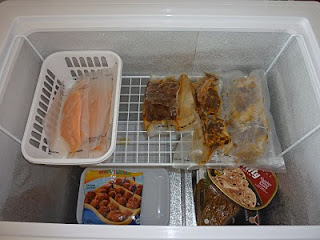
Challah is the egg bread eaten on Friday nights in Jewish homes and synagogues to celebrate the beginning of Shabbat. Traditionally, there are two loaves, to commemorate the Hebrews collecting two portions of manna in the wilderness on Fridays so they could rest on Shabbat. The convenience of having two smaller loaves in the modern age is that you can freeze one for later.
This is Good Housekeeping's recipe, with one major alteration. OK, I cut the recipe in half, and then made a major alteration. Challahs are supposed to be made with water. There is no dairy in a traditional challah so it is pareve (kosher to eat with either meat or dairy meals). That's also why this uses oil instead of butter for its fat. I like my breads made with milk because it adds softness and makes the taste richer. If you are following kosher, or even kosher-style, sub in water for the milk. If you're vegetarian, you don't have to worry about mixing meat and milk, and can make it either way.
The six-strand braid is a lot easier than it sounds. It creates the image of one braid laid upon another, but joined. If you feel that my instructions are vague or incomplete, GH's directions have you divide the dough into 67/33%. The larger piece is one three-strand braid, the smaller another, and you do lay one on top of the other. For many holidays, including Rosh Hashanah, challahs are shaped into a spiral to note the turning of the year.
For a raisin challah, work in 1/2 C golden or dark raisins during the kneading process.
3/4 C milk or water
3 Tb oil
1 Tb sugar
1 package (2-1/2 tsp) dry yeast
3+ C flour
1 tsp salt
3 eggs
1. Warm milk, oil, and sugar to 100º. Stir in yeast and set aside until foamy, about 5 min.
2. While yeast is proofing, combine salt and 1 C flour. Separate one of the eggs and put the yolk in the fridge for later.
3. In stand mixer, combine the 1 C flour and liquid ingredients. Beat with the paddle attachment on medium for 2 minutes into a smooth batter. Add 1 C flour, the 2 whole eggs, and the egg white. Beat again until
smooth. If dough is too soft to knead, beat in another 1/2 C flour.
4. Liberally flour kneading surface. Pour dough on to board. Knead until dough is smooth, about 10 minutes. Try to add as little flour as possible. An egg dough will always be a little sticky. Just because it sticks to the board a little doesn't mean it isn't ready.
5. Place dough in a lightly oiled bowl and turn to grease all sides. Let rise in a warm place until doubled, about 1 hour. Punch down and let rest for 10 minutes.
6. If making one loaf, divide dough into 6 equal pieces. If making two smaller loaves, make 12 equal pieces. A food scale comes in handy, as you can divide the dough by weight instead of estimating size. Roll each into a long rope, about as long as you want to make the loaf, all equal in length. Take 6 strands and press the "top" ends together, fanning them out a little. The braid sequence follows:
7. Place loaf on a cookie sheet lined with greased parchment paper (see note from the
strudel recipe about egg-washed items). Place in warm place to proof until doubled, about 1 hour.
8. Preheat oven to 375º. Beat egg yolk until smooth, adding a teaspoon of water if necessary. Thoroughly brush loaf with egg wash. Bake for 35 minutes for a large loaf, 20-25 for two smaller ones. They will be dark golden and sound slightly hollow when tapped. Remove to a wire rack until cool.
makes 1 1-1/2-lb loaf or 2 12-oz loaves
Difficulty rating :-0
 Whoever the lazy chef was who didn't feel like tearing up his salad greens is probably rich now. Wedge salads have become trendy, and they are stupidly easy to make. Whether you go for a basic iceberg lettuce, or strive to impress with endive, these are all about the presentation. If it looks pretty, your guests will be impressed.
Whoever the lazy chef was who didn't feel like tearing up his salad greens is probably rich now. Wedge salads have become trendy, and they are stupidly easy to make. Whether you go for a basic iceberg lettuce, or strive to impress with endive, these are all about the presentation. If it looks pretty, your guests will be impressed.









 Challah is the egg bread eaten on Friday nights in Jewish homes and synagogues to celebrate the beginning of Shabbat. Traditionally, there are two loaves, to commemorate the Hebrews collecting two portions of manna in the wilderness on Fridays so they could rest on Shabbat. The convenience of having two smaller loaves in the modern age is that you can freeze one for later.
Challah is the egg bread eaten on Friday nights in Jewish homes and synagogues to celebrate the beginning of Shabbat. Traditionally, there are two loaves, to commemorate the Hebrews collecting two portions of manna in the wilderness on Fridays so they could rest on Shabbat. The convenience of having two smaller loaves in the modern age is that you can freeze one for later.





